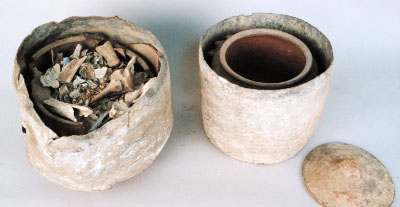
Left: KM 2904. Cremation urn in lead container, contents intact.
Right: KM 2903. Ceramic cremation urn in lead container. Contents have been removed and analyzed.



Right: KM 2903. Ceramic cremation urn in lead container. Contents have been removed and analyzed.
Social status was an important factor in the Roman funeral. The dead were put on display for a period of time dependent upon the departed person's position in society. The length of this ancient "wake" varied greatly. Upper-class individuals such as the nobility were often put on display for as long as a week, offering many opportunities for many mourners to pay their final respects. Lower class members of society, on the other hand, were often cremated after only one day.
After the display, a funerary procession followed. Roman funerals were typically held at night to prevent large public gatherings and discourage crowds and excessive mourning which, in the case of major political figures, could lead to serious unrest. Hired musicians led the parade, followed by mourners and relatives who often carried portrait sculptures or wax masks of other deceased family members. The procession would end outside of town (it was forbidden to bury anyone within the city limits) and a pyre, or cremation fire, was built. As the fire burned, a eulogy was given in honor of the deceased. After the pyre was extinguished, a family member (usually the deceased's mother or wife) would gather the ashes and place them in an urn.
The urns shown here consist of an inner terracotta pot and lid, formed from a red clay characteristic of much Roman pottery and an outer lead container sealed by a lead lid (not shown), which helped protect the fragile ceramic urn in an environment such as a columbarium. A typical columbarium was a dirty, dank, subterranean mausoleum holding dozens of cremation burials.